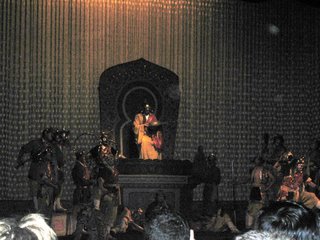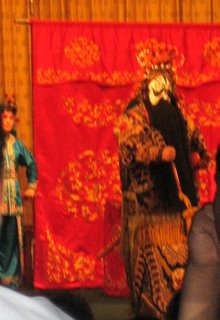The Beijing Opera

Beijing Opera is a style of performance which is, ironically enough, not actually local to Beijing -- rather, it originated in Anhui, and inland province to the south of Beijing. However, in 1790 a c
 ouple of troupes of entertainers from Anhui came to the imperial court in Beijing, and were such at hit that they stayed. The style merged with existing tunes and forms of entertainment and now is one of Beijing's cultural attractions. Everything from the funny boots to the elaborate costumes and makeup has a meaning, which you can read a little about here.
ouple of troupes of entertainers from Anhui came to the imperial court in Beijing, and were such at hit that they stayed. The style merged with existing tunes and forms of entertainment and now is one of Beijing's cultural attractions. Everything from the funny boots to the elaborate costumes and makeup has a meaning, which you can read a little about here.This first picture is from the first act, which featured singing and dancing by a few characters, most notably the guy in this picture (the King of the Qin, I think) and his wife, who winds up killing herself to save her King from worrying about her while he fights a losing battle against the invading Chen army. It was really interesting to listen to the singing and speaking -- it was quite unlike anything I've ever heard before. There are sound clips of a performance here, if you want to check it out. The guy in teal behind the King is a courier who arrives to inform him of the army's increasingly desperate position. The words being sung were presented on electronic boards at the sides of the stage (in Chinese, but with English translations), which was useful because, not unlike our own
 performances of Shakespeare back in the western world, performances of Beijing Opera still make use of the dialect and formalities present when the art form was first created more than 2oo years ago, so even Chinese audiences would have some trouble getting the gist of what was going on without a little bit of help from having the written words in front of them.
performances of Shakespeare back in the western world, performances of Beijing Opera still make use of the dialect and formalities present when the art form was first created more than 2oo years ago, so even Chinese audiences would have some trouble getting the gist of what was going on without a little bit of help from having the written words in front of them.We got to watch the performers putting on their makeup before the performance -- the half-made-up guy below was part of the second act of the show, a long and elaborate acrobatic act which literally took our breath away... the talent these guys had was completely unbelievable, although there was no singing during this performance. According to some reading I've done, even the colors used to paint the characters' faces have meaning: yellow and white are used to represent cunning, while red stands for uprightness and loyalty. The Queen above has a good deal of red on her face, demonstrating her extreme loyalty to her beseiged husband, although I'm not sure you can see that in the picture as it's a bit blurry. Black, which you see on the face and in the beard of the noble King above, is used to show valor and wisdom, while blue and green indicate the vigorous and enterprising character of rebellious heroes. The gold and silver of the first picture, which shows the high Buddhist king (I think in the Kingdom of Heaven, though I'm not sure), represent supernatural power.
 Interestingly enough, there is currently a kind of rescue mission underway to try to save this form of entertainment, which, like so many of China's cultural art forms, suffered during the Cultural Revolution. All the old forms of opera were outlawed and replaced with the "Eight Model Plays" of Chinese nationalism, featuring class struggle, communist anti-Japanese activity after the war, and so on. While some of these nationalistic plays are still performed today, there is currently an effort to bring back the older forms -- like the ones we saw last night. All in all, it was a truly awesome performance, and a really interesting cultural thing to do -- apart from just studying the language, or using it to buy things like alarm clocks and meals, we were able to sit back and begin to appreciate some of the immensely rich and beautiful culture of this country.
Interestingly enough, there is currently a kind of rescue mission underway to try to save this form of entertainment, which, like so many of China's cultural art forms, suffered during the Cultural Revolution. All the old forms of opera were outlawed and replaced with the "Eight Model Plays" of Chinese nationalism, featuring class struggle, communist anti-Japanese activity after the war, and so on. While some of these nationalistic plays are still performed today, there is currently an effort to bring back the older forms -- like the ones we saw last night. All in all, it was a truly awesome performance, and a really interesting cultural thing to do -- apart from just studying the language, or using it to buy things like alarm clocks and meals, we were able to sit back and begin to appreciate some of the immensely rich and beautiful culture of this country.


<< Home